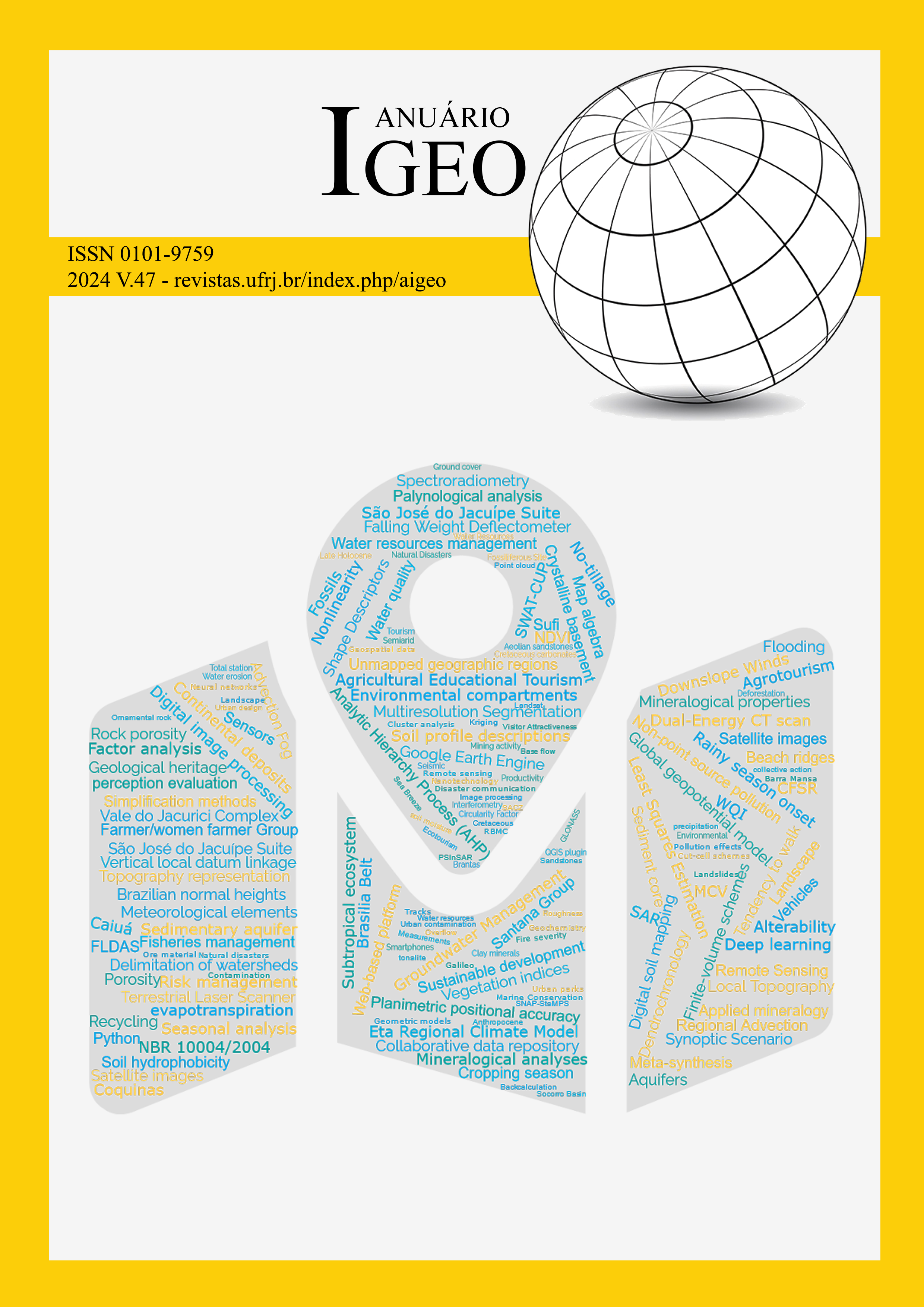Leaching Efficiency of 238U and 232Th series from Granitic Soils
DOI:
https://doi.org/10.11137/1982-3908_2024_47_62612Keywords:
HPGe detector, Radio nuclides, Radioactivity concentrationAbstract
Granitic soil, a uranium (U) and thorium (Th)-bearing soil body, can be sourced to extract fissionable nuclides through leaching using acidic solutions. Limited research indicates the feasibility of extracting U and Th from granitic sources, necessitating further studies to optimize leaching efficiency and its potential as a fissionable fuel. This study investigates the leaching efficiency of the uranium 238U and thorium 232Th series, as well as 40K, in granitic soil samples. The study utilized a high-purity germanium detector (HPGe) to quantify the activity levels of the 238U and 232Th series and 40K in the studied samples. The black sand deposit and tin-tailing samples were also utilized to benchmark the finding of the leaching efficiency of the uranium 238U and thorium 232Th in granitic samples. The study found that the leaching samples contained low radioactivity levels that were a few to tenth times lower compared to the original samples, with tin-tailing samples exhibiting the highest leaching activity for 238U (630.05 Bq l-1) and 232Th (512.17 Bq l-1) and comparable to granitic soil samples 238U (437.7 Bq l-1) and 232Th (23.9 Bq l-1). Sulfuric acid showed the most efficient leaching reagent ~ up to 23% and 32% for 232Th and 238U, respectively. In comparison, nitric and hydrochloric acids exhibited low leaching efficiencies, ~ 1 – 13%. Overall, granitic soil shows comparable leaching rates to conventional sources of natural uranium nuclear fuel, making it a potential secondary and alternative nuclear fuel source.
References
Alsaadi, S.D.Y., Ali, J.M., Hazawi, A. & AL-abrdi, A.M. 2021, 'Measurements of Radioactivity Concentrations in Granites and Sedimentary- Rocks and their Leaching Components in Egyptian Deserts', Al-Mukhatar Journal of Science, vol. 36, no. 1, pp. 12-23, DOI:10.54172/mjsc.v36i1.6.
Arunima, S., Lekshmi, R., Jojo, P.J. & Uddin, K.M. 2021, 'A study on leaching of primordial radionuclides 232Th and 40K to water bodies', Radiation Physics and Chemistry, vol. 188, 109658, DOI:10.1016/j.radphyschem.2021.109658.
Bhargava, S.K., Ram, R., Pownceby, M., Grocott, S., Ring, B., Tardio, J. & Jones, L. 2015, 'A review of acid leaching of uraninite', Hydrometallurgy, vol. 151, pp. 10-24, DOI:10.1016/j.hydromet.2014.10.015.
Derin, M.T., Vijayagopal, P., Venkatraman, B., Chaubey, R.C. & Gopinathan, A. 2012, 'Radionuclides and radiation indices of high background radiation area in Chavara-Neendakara placer deposits (Kerala, India)', PLoS One, vol. 7, no. 11, e50468, DOI:10.1371/JOURNAL.PONE.0050468.
Edwards, C.R. & Oliver, A.J. 2000, 'Uranium processing: A review of current methods and technology', Jom: The Journal of The Minerals, Metals & Materials Society, vol. 52, no. 9, pp. 12-20. DOI:10.1007/s11837-000-0181-2.
Huang, J., Li, M., Zhang, X., Huang, C. & Wu, X. 2017, 'Extraction of uranium from tailings by sulfuric acid leaching with oxidants', IOP Conference Series: Earth and Environmental Science, vol. 69, no. 1, 012050, DOI:10.1088/1755-1315/69/1/012050.
Imam, A.N.N., El, I.E. & Ghanem, A.A. 2019, 'Effect of different concentrations of sulfuric acid on leaching of radionuclide isotopes in sedimentary rock samples , Sinai , Egypt', Journal of Radioanalytical and Nuclear Chemistry, vol. 322, no. 2, pp. 347-59, DOI:10.1007/s10967-019-06754-9.
Khandaker, M.U., Jojo, P.J. & Kassim. H.A. 2012, 'Determination of Primordial Radionuclides in Natural Samples Using HPGe Gamma-Ray Spectrometry', APCBEE Procedia, vol. 1, pp. 187-92, DOI:10.1016/j.apcbee.2012.03.030.
Manaa, E.-S.A., Negm, S.H. & El-Magied, M.O.A. 2018, 'Alkaline leaching of uranium from El-Sibaiya East Phosphorite in the presence of sodium peroxide', Journal of Nuclear and Radiochemical Sciences, vol. 18, pp. 16-23, DOI:10.14494/jnrs.18.16.
Mkhatshwa, S.F., Guy, B.M., Smith, A.J.B. & Viljoen, K.S. 2020, 'A mineralogical perspective on the recovery of uranium from brannerite-rich ore at cooke section, west rand goldfield, south africa', South African Journal of Geology, vol. 123, no. 4, pp. 615-32, DOI:10.25131/sajg.123.0031.
Nada, P., Iman, N. & Ghanem, A. 2007, 'Follow up the leaching efficiency of uranium series from high-grade granite sample with high concentration of sulfuric acid', Proceedings, pp. 60-4.
Ramasamy, V., Sundarrajan, M., Suresh, G., Paramasivam, K. & Meenakshisundaram, V. 2014, 'Role of light and heavy minerals on natural radioactivity level of high background radiation area , Kerala , India', Applied Radiation and Isotopes, vol. 85, pp. 1-10, DOI:10.1016/j.apradiso.2013.11.119.
Downloads
Published
Issue
Section
License

This work is licensed under a Creative Commons Attribution 4.0 International License.
This journal is licensed under a Creative Commons — Attribution 4.0 International — CC BY 4.0, which permits use, distribution and reproduction in any medium, provided the original work is properly cited.

















